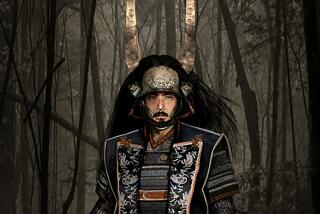Art Review : Japanese Prints of Women Shed ‘Light’ on Culture Shifts
- Share via
Historically, women have acted as culture’s conservators of convention. Thus, when women begin to change it means culture is evolving. A virtually perfect illustration of this proposition is embodied in the exhibition “Light in Darkness: Women in Japanese Prints of Early Showa (1926-1945)” at USC’s Fisher Gallery.
It’s a visually engaging assembly of more than 100 polychrome woodblock prints called shin-hanga (new print). The form began early in the century as a revival of the faded popular art of the ukiyo-e. It came to symbolize much more.
By 1920, Japan numbered among the most powerful of rising imperial and industrial powers. At home it wrestled with the trauma of transformation from an old-fashioned agrarian society to a modern urban one. Militarily successful abroad, it established exploitative colonial rule in parts of China, Korea and the South Seas. All of this was justified by a conservative nationalist ideology.
The shin-hanga print came to embody these right-wing values. It carried the conservative, sentimentalizing message of the regime, showing Japan as the beautiful, placid homogeneous realm of nostalgic memory. The principal embodiment of all this was the traditional Japanese beauty, elegant and submissive in her exquisite kimono.
*
The point is dramatized by curator and USC art historian Kendall Brown. In his catalog essay he cites a 1942 print by Yamakawa Shuho, “Tokyo Station as It Is Now”. The image of the station is virtually obliterated by the figure of a demur Japanese old-style beauty, a bijin. And this was no quirky artist’s fantasy. The piece was commissioned and distributed by the government,
Shin-hanga prints were so closely tied to ossified convention that some critics have dismissed them as essentially propaganda. Sometimes they were. A series by Igawa Sengai has clinkers like a bully depiction of a women’s fire brigade and a particularly brutal Japanese soldier-hero; both look like old Soviet Socialist Realism.
On the whole, however, shin-hanga are such an odd mix of motive, mind-set and style, they can be interesting out of sheer weirdness. The structural basis of this art represents an attempt to meld the exquisite, essentially flat stylizations of traditional Japanese art with both Old Master Western illusionism and avant-garde modernism. When it doesn’t work it’s just a neurotic mess.
When it does it’s fresh and stunning. Yoshida Hiroshi’s “Restaurant at Night” is a wonderfully romantic urban image of atmospheric light and after-rain reflections. Wada Sanzo’s watercolor-like series on ordinary jobs of the period is as sociologically revealing and as it witty and affectionate.
*
Artists who stuck a toe in European modernism also tended to identify with the new-style, Westernized Japanese woman known as moga. The women wore bobbed hair, loved foreign movies, had liberal educations, sported European fashions, went out alone at night, acted sexy and smoked. Just sounds like fun to us, but moga were anathema to the establishment
The type was depicted with relish by Yamamura Koka, employing German Expressionist moves in “New Carleton Dancers.” Yamazaki Junnosuke’s image of a dancer was hip to the Russian avant-garde. Ishikawa Toraji’s suite “Ten Nudes” whiff of Matisse are so frankly naked they don’t seem particularly erotic but they were immediately confiscated.
On the other hand, much more subtly steamy images of geishas were acceptable because these once-scorned prostitutes now represented the good old days.
Anyone tempted by this curiously fascinating art should also take a look at a linked exhibition at the Los Angeles County Museum of Art, “Shin-Hanga: New Prints in Modern Japan.”
* USC, Fisher Gallery, 823 Exposition Blvd., through April 20, closed Sundays, Mondays. (213) 740-4561.
More to Read
The biggest entertainment stories
Get our big stories about Hollywood, film, television, music, arts, culture and more right in your inbox as soon as they publish.
You may occasionally receive promotional content from the Los Angeles Times.










